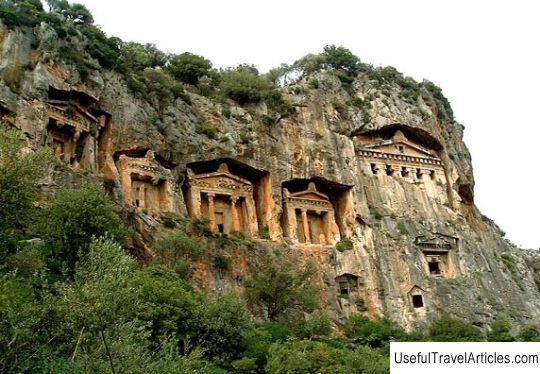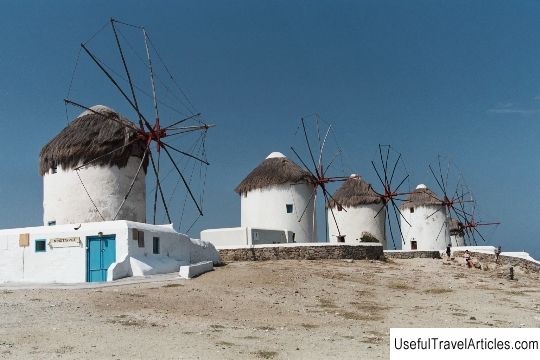Kaunos description and photos - Turkey: Marmaris

Kaunos description and photos - Turkey: Marmaris. Detailed information about the attraction. Description, photographs and a map showing the nearest significant objects. The name in English is Kaunos. Photo and descriptionKaunos is an ancient city in the bay of the Dalyan River, thirty kilometers from Marmaris. The creation of the ancient city is attributed to the 10th century BC. Legends say that the city of Kaunos was built on the Lykia-Karia border. Archaeological excavations are currently underway in the city under the guidance of an outstanding archaeologist and professor Cengiz Ishyk. Kaunos keeps a long history - during its existence, the city was besieged by both the troops of Alexander the Great and the warriors of ancient Rome. As a result of research on the site of the ancient city, objects related to the Ancient, Medieval, Byzantine and Roman periods were discovered. The city, which was one of the main ports during the ancient era, has now moved away from the sea coast due to the formation of the Dalyan delta. Strabo, one of the main geographers and historians of antiquity, said: “Kaunos is on the coast, and Kalbis flows alongside.” He also notes that the city had shipyards and a port, the entrance to which was closed. Considering the geographical location of Kaunos, we can conclude that it is located opposite Rhodes on the southern coast of the Karje. On the north side, the city is surrounded by the Menderes mountains, and on the west, opposite the sea, there are Lycian rock tombs. It is separated by valleys from the rest of the Karya, and its front part looks towards Lycia, located on the southern and eastern parts. The ancient city is located at an altitude of 152 meters above sea level, and the acropolis is located in the southwest of the city ... A small tower on the peninsula, which has a height of about fifty meters, is erected in the form of a tongue, spreading between two hills towards the sea. During the ancient and early classical era, the city walls built on the back of Kaunos, the Little Tower and the Acropolis, as well as the inner city walls, formed a kind of protective shield for the city. Since excavations have not yet been carried out on the entire territory, the exact layout of the ancient city is not completely clear. It is only known that it was extended by terraces during the Hecatomnidler period. Previous terraces were restored, and in subsequent periods new and larger ones were built. The name of the city was mentioned already in the third millennium BC. Kaunos transferred the presence on its territory of a large number of peoples: Ionians, Carians, Persians, Lycians, Romans, Byzantines and Greeks. Beylik Menteshe extended his power here in 1291, and in 1392 these lands were annexed to the Ottoman state by Sultan Bayazid. Rock burials dating back to the fourth century BC became one of the symbols of Kaunos. e. These tombs, clearly visible from Dalyan, were also used during the time of the Romans. In graves of the Lycian type, a lounger was often installed, consisting of three stones. The deceased was laid on this lounger, and the facade of the grave was decorated with a pediment and two Ionian columns. However, not all tombs can be approached; for the bravest, there is a rope ladder. The remains of people buried here have long since decayed. The eternal memory of long-gone civilizations is guarded by two lion heads, which look at each other from the surface of the Carian tombs. Kaunos was an important trading and port city. Over time, the bay, as a result of silt deposits, lost its importance and became shallow. According to Herodotus, the inhabitants of Kaunos called themselves the natives of Girith. The city was founded by the son of Miletos, Kaunos, who was expelled from his parental home due to a forbidden relationship with his sister. The pier is located ten minutes walk from the city. Those arriving here on yachts leave their ships near the Delikli Island and come along the canal on boats to the pier. The city port was located in the area of Lake Syulyuklyu at the foot of the acropolis. The sea in those years was at the level of the acropolis itself. When all of Anatolia was under the influence of Persia, during the Persian invasion, Kaunos came under the control of Mavsol. After Alexander the Great defeated the Persians, the city was ruled by the princess of Hell, then Antigonus, and after Ptolemeus. The city was part of the Rhodes and Bergama kingdoms in turn. Fragments of the walls located on the north side are medieval buildings. The longest wall starts from the north side of the port and extends to the sheer cliffs near the village of Dalyan. The northern part of the wall was erected during the reign of Mavsol. The buildings on the northwest side were erected during the Hellenic period, while those located directly near the port belong to even earlier eras. At the foot of the acropolis there is a theater. Its parterre has thirty-three rows of seats. One of the buildings located to the west of the theater is a basilica-like church. The rest of the ruins belonged to the temple and the bathhouse. Behind the building which has a contour in the form of an open circle and is decorated with smooth columns, you can see a podium standing on three steps. Historians suggest that this is also the ruins of some temple. It is not known what the round foundation was based on. During excavations in the area of the old port in the northern part, a gallery of honors was found. In its vicinity there are many pedestals, but the statues themselves could not be found. The source found near the gallery has now been restored. In its vicinity there are many pedestals, but the statues themselves could not be found. The source found near the gallery has now been restored. In its vicinity there are many pedestals, but the statues themselves could not be found. The source found near the gallery has now been restored.   We also recommend reading Church of the Holy Trinity description and photos - Great Britain: Stratford-upon-Avon Topic: Kaunos description and photos - Turkey: Marmaris. |




